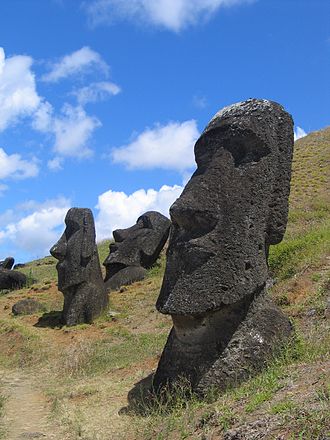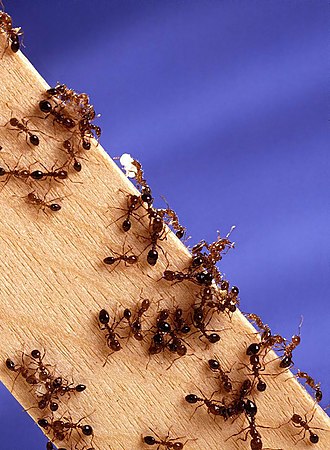So far we discussed what Social Cognition is about. But how could this behaviour develop during evolution? At first glance, Darwin’s theory of the survival of the fittest does not support the development of social behaviour. Caring for others, and not just for oneself, seems to be a decrease of fitness. Nevertheless, various theories have been formulated which try to explain Social Cognition from an evolutionary perspective. We will present three influential theories which have been formulated by Steven Gaulin and Donald McBurney.[2]
Group Selection

Moai at Rano Raraku
Vero Wynne-Edwards first proposed this theory in the 1960s. From an evolutionary perspective, a group is a number of individuals which affect the fitness of each other. Group Selection means that if any of the individuals of a group is doing benefit to its group, the group is more likely to survive and pass on its predisposition to the next generation. This again improves the chance of the individual to spread its genetic material. So in this theory a social organism is more likely to spread its genes than a selfish organism. The distinction to the classical theory of evolution is that not only the fittest individuals are likely to survive, but also the fittest groups.
An example would be the history of the Rapa Nui. The Rapa Nui were the natives of Easter Island which handled their resources extremely wasteful in order to build giant heads made of stone. After a while, every tree on the island was extinct because they needed the trunks to transport the stones. The following lack of food led to the breakdown of their civilization.
A society which handles their resources more moderate and provident would not have ended up in such a fate. However, if both societies would have lived on one island, the second group would not have been able to survive because they would not have been able to keep the resources.
This indicates the problem of the Group Selection: it needs certain circumstances to describe things properly. Additionally, every theory about groups should include the phenomenon of migration. So in this simple form, the theory is not capable of handling selfish behaviour of some agents in altruistic groups: Altruistic groups which include selfish members would turn into pure selfish ones over time, because altruistic agents would work for selfish agents, thereby increasing the cheaters' fitness while decreasing their own. Thus, Group Selection may not be a sufficient explanation for the development of Social Cognition.
Kin Selection
Since altruistic populations are vulnerable to cheaters, there must exist a mechanism that allows altruism to be maintained by natural selection. The Kin Selection approach provides an explanation how altruistic genes can spread without being eliminated by selfish behaviour. The theory was developed by William D. Hamilton and John M. Smith in 1964.[3] The basic principle of Kin Selection is to benefit somebody who is genetically related, for example by sharing food. For the altruistic individual, this means a reduction of its own fitness by increasing the fitness of its relative. However, the closer the recipient is related to the altruist, the more likely he shares the altruistic genes. The loss of fitness can be compensated since the genes of the altruistically behaving agent have then the chance to be spread indirectly through the recipient: The relative might be able to reproduce and pass the altruistic genes over to the next generation.
In principle, the disadvantage for the giver should always be less than the increased fitness of the addressee. This relation between costs and benefit is expressed by Hamilton's rule taking additionally the relatedness of altruist and recipient into account:
\(r\cdot b>c\)
where
- r shows the genetic relatedness between altruist and recipient (coefficient between zero and one),
- b is the reproductive benefit or increased fitness for the recipient and
- c are the altruist's reproductive costs or the reduction of his fitness in the performed action.
If the product of relatedness and benefit outweighs the costs for the giver, the altruistic action should be performed. The closer the recipient is genetically related, the higher costs are acceptable.

Ant colonies provide evidence for Kin Selection
Examples for kin-selected altruism can be found in populations of social insects like ants, termites or bees. An ant colony, for instance, consists of one fertile queen and several hundreds or more of sterile female workers. While the queen is the only one reproducing, the workers are among other things responsible for brood care. The workers are genetically closer related to the sisters they raise (75%) than they would be to their own offspring (50%). Therefore, they are passing on more of their genes than if they bred on their own.
According to Hamilton's rule, altruism is only favoured if directed towards relatives, that is {\displaystyle r>0}![r]() 0" aria-hidden="true" src="https://wikimedia.org/api/rest_v1/me...ec42790850b452">. Therefore, Kin Selection theory accounts only for genetic relatives. Altruism however occurs among not related individuals as well. This issue is addressed by the theory of Reciprocal Altruism.
0" aria-hidden="true" src="https://wikimedia.org/api/rest_v1/me...ec42790850b452">. Therefore, Kin Selection theory accounts only for genetic relatives. Altruism however occurs among not related individuals as well. This issue is addressed by the theory of Reciprocal Altruism.
Reciprocal Altruism
The theory of Reciprocal Altruism describes beneficial behaviour in expectation of future reciprocity. This form of altruism is not a selfless concern for the welfare of others but it denotes mutual cooperation of repeatedly interacting species in order to maximise their individual utility. In social life an individual can benefit from mutual cooperation, but each one can also do even better by exploiting the cooperative efforts of others. Game Theory allows a formalisation of the strategic possibilities in such situations. It can be shown, that altruistic behaviour can be more successful (in terms of utility) than purely self-interested strategies and therefore will lead to better fitness and survivability.
In many cases social interactions can be modelled by the Prisoner's Dilemma, which provides the basis of our analysis. The classical prisoner's dilemma is as follows: Knut and his friend are arrested by the police. The police has insufficient evidence for a conviction, and, having separated both prisoners, visits each of them to offer the same deal: if one testifies for the prosecution against the other and the other remains silent, the betrayer goes free and the silent accomplice receives the full ten-year sentence. If both stay silent, the police can sentence both prisoners to only six months in jail for a minor charge. If each betrays the other, each will receive a two-year sentence.
Possible outcomes of the Prisoner's Dilemma:
| Prisoner 1 / Prisoner 2 |
Cooperate |
Defect |
| Cooperate |
6 months each |
10 years / free |
| Defect |
free / 10 years |
2 years each |
Each prisoner has two strategies to choose from, to remain silent (cooperate) or to testify (defect). Assume Knut wants to minimize his individual durance. If Knut's friend cooperates, it is better to defect and go free than to cooperate and spend six months in jail. If Knut's friend defects, then Knut should defect too, because two years in jail are better than ten. The same holds for the other prisoner. So defection is the dominant strategy in the prisoner's dilemma, even though both would do better, if they cooperated. In a one-shot game a rational player would always defect, but what happens if the game is played repeatedly?
One of the most effective strategies in the iterated prisoner's dilemma is the mixed strategy called Tit for Tat: Always cooperate in the first game, then do whatever your opponent did in the previous game. Playing Tit for Tat means to maintain cooperation as long as the opponent does. If the opponent defects he gets punished in succeeding games by defecting likewise until cooperation is restored. With this strategy rational players can sustain the cooperative outcome at least for indefinitely long games (like life).[4] Clearly Tit for Tat is only expected to evolve in the presence of a mechanism to identify and punish cheaters.
Assuming species are not able to choose between different strategies, but rather that their strategical behaviour is hard-wired, we can finally come back to the evolutionary perspective. In The Evolution of Cooperation Robert Axelrod formalised Darwin's emphasis on individual advantage in terms of game theory.[5] Based on the concept of an evolutionary stable strategy in the context of the prisoner's dilemma game he showed how cooperation can get started in an asocial world and can resist invasion once fully established.




